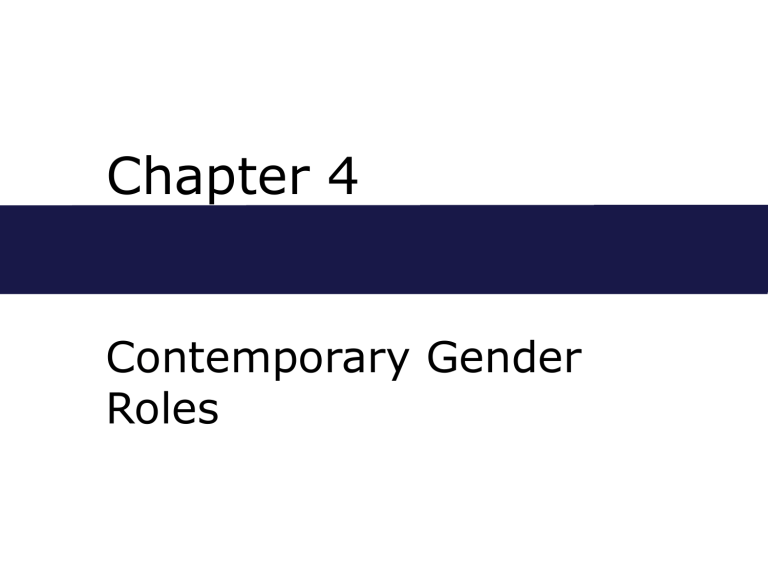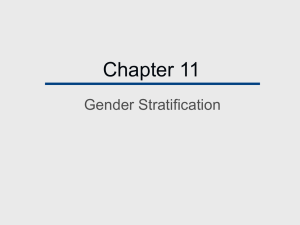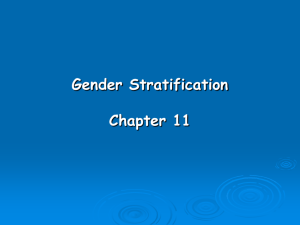Chapter 4 - Cengage Learning

Chapter 4
Contemporary Gender
Roles
Chapter Outline
Understanding Gender and Gender
Roles
Gender and Gender Socialization
How Family Matters: Learning Gender
Roles
Gender Matters in Family Experiences
Constraints of Contemporary Gender
Roles
Gender Movements and the Family
Gender Roles
A gender role is the role a person is expected to perform as a result of being male or female in a particular culture.
Gender-role stereotypes are beliefs that males and females, as a result of their sex, possess distinct psychological and behavioral traits.
Gender Roles
Gender role attitudes are beliefs regarding appropriate male and female personality traits and activities.
Gender role behaviors are actual activities or behaviors that we or others engage in as males and females.
Gender identity refers to being male or female.
Gender Differences
Men and women are more similar than different.
Innate gender differences are generally minimal.
Differences are encouraged by socialization.
Within any society there are multiple versions of masculinity and femininity, one of which comes to dominate our thinking about gender.
Gender Theory
The idea that social relationships are based on socially perceived differences between males and females that justify unequal power relationships.
The key to creating gender inequality is the belief that men and women are opposite in personalities, abilities, skills, and traits.
Social Learning Theory
Emphasizes learning behaviors from others through rewards and punishments and modeling.
This approach has been modified to include cognitive processes, such as the use of language, the anticipation of consequences, and observation.
Cognitive Development
Theory
Asserts that once children learn gender is permanent, they independently strive to act like
“proper” boys or girls because of an internal need for congruence.
How Parents Socialize
Children
Four very subtle processes:
Manipulation
Channeling
Verbal appellation
Activity exposure
Gender Role Socialization
Parents, teachers, and peers are important agents of socialization during childhood and adolescence.
Ethnicity and social class also influence gender roles.
Traditional male roles
Emphasis is on dominance and work, whether for whites, African
Americans, Latinos, or Asian
Americans.
A man’s central family role has been viewed as being the provider.
For women, there is greater role diversity according to ethnicity.
Traditional Female Roles
Among middle-class whites the emphasis is on being a wife and mother.
Among African Americans, women are expected to be instrumental; there is no conflict between work and motherhood.
Among Latinos, women are deferential to men generally from respect rather than subservience; elders, regardless of gender, are afforded respect.
Changes Affecting
Contemporary Gender Roles
Acceptance of women as workers and professionals.
Increased questioning of motherhood as a core female identity.
Greater equality in marital power.
Breakdown of the instrumental/ expressive dichotomy.
Expansion of male family roles.
Limitations of Contemporary
Gender Roles: Men
The provider role limits men’s father and husband roles.
Difficulty in expressing feelings.
A sense of dominance that precludes intimacy.
Limitations of Contemporary
Gender Roles: Women
Diminished self-confidence and mental health.
Association of femininity with youth and beauty creates a disadvantage as women age.
Ethnic women may suffer both racial discrimination and gender-role stereotyping, which compound each other.
Difficulties in Changing
Gender-role Behavior
Each sex reinforces the traditional roles of its own and the other sex.
We evaluate ourselves in terms of fulfilling gender-role concepts.
Gender roles have become an intrinsic part of ourselves and our roles.
The social structure reinforces traditional roles.
Social Movements
Dedicated to Changing
Gender Roles
Gender-reform feminism
Gender-resistant feminism
Movements designed to emphasize how gender overlaps with other bases of oppression, like age, race or class.
Profeminist men’s movements
Most current men’s movements attempt to reconnect men with families.







